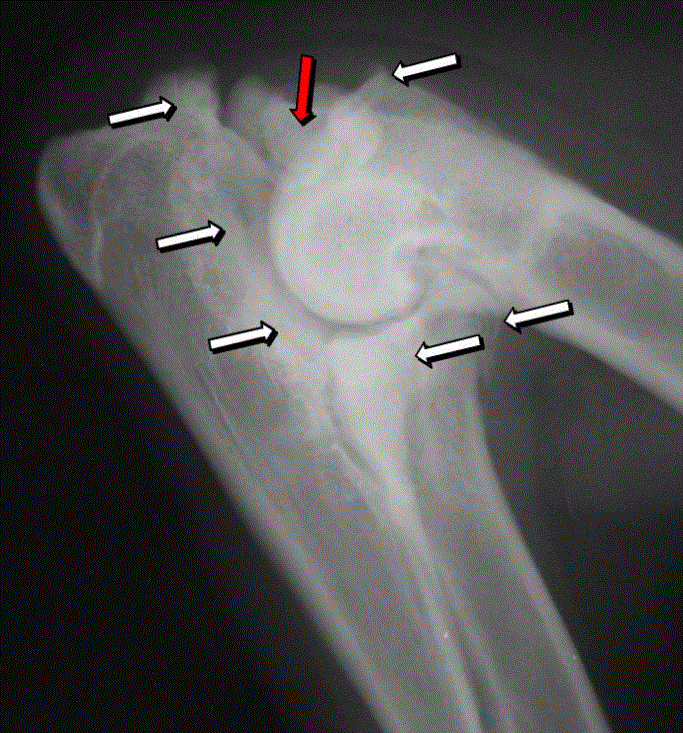Many times we get out of bed in the morning stiff and sore and hunched while walking across the bedroom floor.
This can be due to over-exertion from yard work or strenuous exercise the previous day. Pain and stiffness can also be caused by arthritis and often, once we get moving, the pain may ease somewhat.
We may suffer from age-related arthritis, rheumatoid arthritis or arthritis may be due to an old injury or broken bone.
What if we have canine members of our family? Do they ever suffer from arthritis? Yes, some dogs do.
Arthritis is certainly not a death sentence for humans or for our canine friends as well. Dogs cannot tell us how they are feeling so we must gauge their comfort from their actions, activity level and if we sense they are in pain. We want our dogs to have a good quality of life and not suffer needlessly.
In this post I will answer the question, “How long can a dog live with arthritis?” I will also include information about signs of arthritis in dogs and end-stage arthritis in dogs.

For your dog’s vitamin supplement, food, toys, or other dogs product please visit the Health Extension website.
What Is Arthritis?
Human arthritis and canine arthritis are similar in that inflammation in joint areas causes pain. The disease of arthritis is a degenerative one and causes joints to deteriorate.
It produces abrasion and grating between two joints resulting in sore, aching, and uncomfortable joints and inflammation along with stiffness and often limited range of motion.
The below picture of a German shepherd mix on the x-ray is wearing a cast to help it heal from its broken leg. The white arrows show osteoarthritis in various joints, including the knee joint and several other spots that are harder for me to identify with my limited knowledge of anatomy.
There’s also an isolated Processus Annodus present near where there might be another bone I can’t see because of how tightly packed everything together looks here.
The dog has arthritis all over his body, but when you take a close look at one spot (the left elbow) he seems particularly vulnerable around this part of his forearm called the proximal ulna:
just below where we would expect him to have bones sticking out if he were upright like humans do instead.
To check your Dogs’ health status or their DNA checks, please visit the Embark vet website for all the help you may need.

Types of Arthritis
There are three dissimilar types of arthritis and each has distinct causes. They are listed below.
Osteoarthritis
This is the most common form of arthritis in dogs and is generally found in geriatric dogs due to wear and tear on their joints over the years.
Osteoarthritis can sometimes be found in younger dogs due to the malformation of hip dysplasia that many large-boned canines are prone to.
Osteoarthritis is staged from stage one to stage four. In stage one, the wearing down of cartilage begins, causing inflammation and friction with only sporadic pain and displaying no issues of impaired mobility.
As the staging numbers go up, the disease worsens until in stage four, there is minimal to no cartilage left in between bones causing increased inflammation, very limited mobility, and severe pain resulting in your dog crying out during movement.
Polyarthritis
This is medically referred to as immune-mediated polyarthritis and occurs when your dog’s immune system wages an attack on healthy joint tissue.
This form of arthritis is found more often in breeds that are medium to large in sizes such as spaniels, retrievers, and German shepherds.
Some causes are non-erosive polyarthritis, meaning they cause no substantial changes to the joints and erosive polyarthritis which causes major damage and deformity to the affected joints. Listed below are sub-types of polyarthritis.
Non-erosive Polyarthritis
- Vaccine-induced polyarthritis (after a few days this generally resolves itself)
- Idiopathic polyarthritis
- Polyarthritis/polymyositis syndrome
- Systemic lupus erythematosus
- Breed-specific polyarthritis
Erosive Polyarthritis
- Rheumatoid arthritis (genetic in nature and similar to human RA but not very common)
- Felty’s Syndrome (extremely rare)
Signs of Arthritis In Dogs
- Stiffness when standing, walking, or trying to lay down
- Difficulty rising, sitting, lying, or standing
- Favoring one leg over another result in limping
- Difficulty climbing stairs or trouble getting in and out of the car or up onto a bed or couch
- No interest or very reluctant to play or go for walks
- Swollen, tender joints
- Snaps or yelps when the affected area is touched
- Lethargy – pain, and difficulty with movement cause exhaustion
- Irritable/cranky
- Loss of Appetite
- Fever (inflammatory arthritis)
- Back Pain
- Slow-moving and Difficulty Navigating
- Atrophied Muscles from Inactivity
How Long Can a Dog Live With Arthritis?
This question can have many different answers and depends on a wide variety of scenarios.
The type of arthritis will play a role in the severity of development, but so can how early an arthritis diagnosis is made and treatment started.
If you and your veterinarian suspect arthritis and if it is treated at the onset, chances are much better for a good quality of life as well as a long life for your buddy.
If arthritis is diagnosed at a young age, the proper treatment should be sought after to slow progression. If arthritis has an underlying condition, autoimmune in nature, this issue must be treated as well.
Don’t just assume and accept that your senior dog has just slowed down and is moping around because they are old.
Make a veterinarian appointment to see, perhaps if they are suffering from arthritis. Of course, they will slow down as they get older, but dogs can tolerate pain quite well and they may have become more sedentary because they are uncomfortable.
How long your dog lives with arthritis also depends on its weight. An overweight pet puts extra stress on joints and can exacerbate already painful arthritis.
Your dog should also have an exercise that suits their mobility level so muscles do not atrophy and the activity will also help with stiffness.
There are times however when arthritis becomes just too much for your dog and it is up to you, their family, and caretaker to realize this.
If treatments do not help, they are in significant pain and are mostly sedentary and immobile, you may have to make the painful decision of having your dog euthanized.
Euthanization is not painful for them and they would no longer be struggling and suffering.
Treatments For Arthritis
Treatments for arthritis vary depending on the type and age of your pet and the severity of the disease.
Treatment should begin at the first signs so your pup can lead a comfortable life. Below are treatments for arthritis.
- Physical therapy, including water therapy
- Swimming
- Cold laser therapy
- Massage
- Acupuncture
- Supplements – Glucosamine, Chondroitin, Omega 3 Fatty Acids
- Weight Loss
- NSAIDs (non-steroidal anti-inflammatory drugs) for dogs. Never use over-the-counter human NSAIDs. Generally prescribed are codeine, methocarbamol, gabapentin, and amantadine.
- Topical Pain Relievers
- CBD oil – This has been proven to help with both inflammation and pain in dogs in oral and topical forms.
End-Stage Arthritis In Dogs
Arthritis in dogs has different stages; mild, moderate, and severe. Severe is the pre-cursor to end-stage arthritis and the most important step in this stage is to control pain.
By end-stage arthritis, NSAIDs do not control pain or inflammation any longer, so your veterinarian will bring out the “big guns” of corticosteroids such as dexamethasone and prednisone.
Most veterinarians don’t like to use corticosteroids early on as they break down more tissue and cause further damage, but in the end stage, the only consideration is keeping your pup comfortable.
If your dog is in crippling pain, mobility is no longer a consideration and they can’t even rise, then the last step would be euthanasia.
Even though you do not want to say goodbye to your beloved pup, this is the only course of action left and a responsible one as well.
You have done all you can and your best friend is suffering and has no quality of life. This is the best and most humane choice.
To answer the question, “How long can a dog live with arthritis?” this can be many, many years. The key is quality of life and to have that, treatment should begin early to manage and slow progression.
Arthritis for dogs, just as in humans, is by no means a death sentence. Your dog can live a full and rewarding life, even with arthritis.